
manual new home sewing machine
Model Identification
Locate the model number on the back plate or front lip․ Models often start with 5?? or 6??, indicating production from the mid-1970s to early 1980s․ Janome, which acquired New Home in 1960, manufactures these durable machines․
1․1․ Locating the Model Number
The model number of your New Home sewing machine is typically found on a metal plate or engraved directly on the machine․ Check the base, back, or near the bobbin area for a small plate with serial and model numbers․ This information is crucial for identifying the specific model and accessing the correct manual or replacement parts․ If the model number is worn or missing, contact the manufacturer or a certified dealer for assistance in identifying your machine․ Always ensure accuracy when noting the model number for future reference․
1․2․ Understanding the Production Era
Identifying the production era of your New Home sewing machine helps determine its features and maintenance requirements․ Early models from the 1900s often have simpler mechanisms, while later models may incorporate advanced technology․ The production era can be estimated by the serial number, usually located on the machine’s base or a serial plate․ Machines produced before the 1950s are considered vintage, while those from the 1960s to 2000s are more modern․ This knowledge aids in troubleshooting and finding compatible parts․ Always consult the manual or a sewing machine expert for precise era identification․
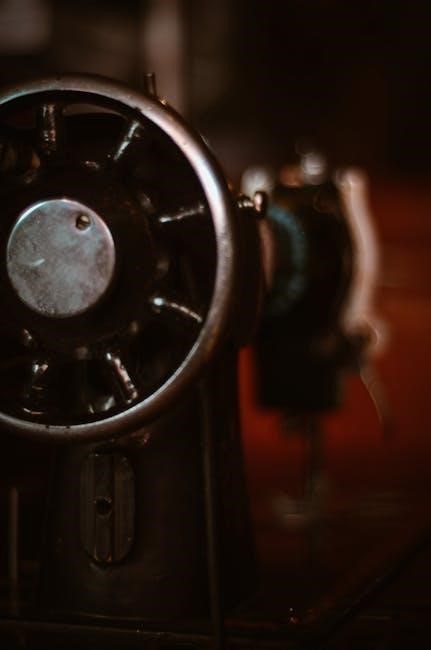
Locating the Manual
Locate your New Home sewing machine manual through official websites, offering downloadable PDFs․ Third-party sites and sewing communities also provide access or know where to find them․
2․1․ Finding Free Manuals Online
To find free manuals for your New Home sewing machine, start by visiting the official manufacturer’s website, as many brands provide downloadable PDF versions․ Additionally, websites like ManualsLib and ManualsOnline offer extensive libraries of free manuals․ Sewing communities and forums often share links to manuals, while platforms like eBay may have sellers offering free PDF downloads․ Always verify the model number matches your machine for accuracy․ These resources ensure you can access the guide without cost, helping you operate your sewing machine effectively․
2․2․ Purchasing Manuals
If free manuals are unavailable, purchasing a physical or digital copy is a reliable option․ Online marketplaces like Amazon and Etsy often sell vintage and modern sewing machine manuals․ Specialized sewing stores or the Singer Sewing Company may also offer manuals for New Home models․ Additionally, eBay frequently has listings for rare or out-of-print manuals․ Purchasing ensures access to high-quality, original instructions tailored to your machine․ Always verify seller reviews and manual compatibility before buying․
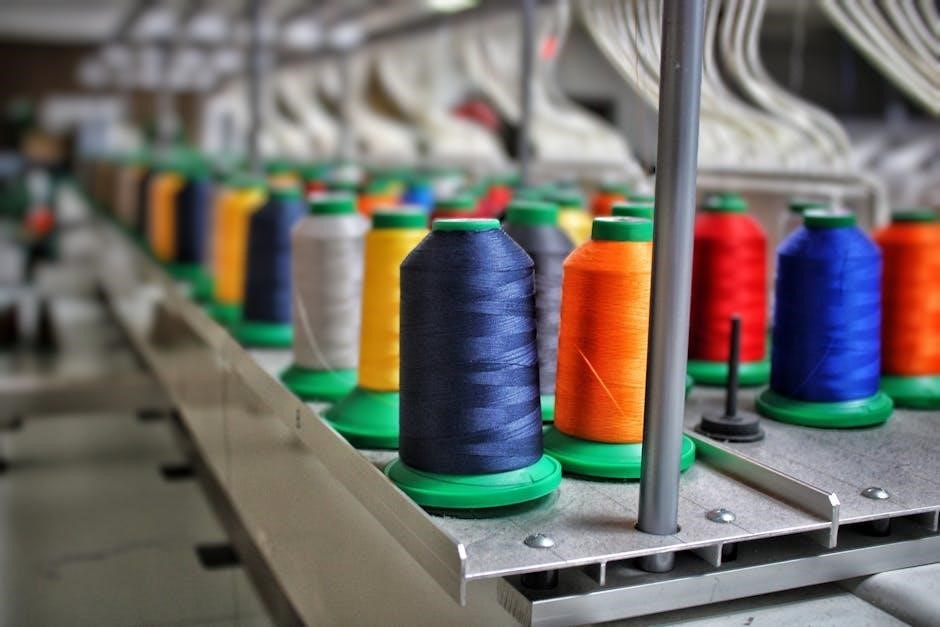
Features of the Machine
The New Home sewing machine features sturdy construction, versatile stitch options, and user-friendly controls․ It combines mechanical reliability with ergonomic design, ensuring precise and efficient sewing․
3․1․ Mechanical Features
The New Home sewing machine boasts a durable metal frame, ensuring stability during operation․ It features an oscillating hook system for consistent stitch formation and a manual tension control for precise fabric handling․ The machine includes a balance wheel for easy manual operation and a take-up lever to adjust stitch length and tension․ These components work together to provide smooth sewing performance and versatility for various fabrics and projects․ The mechanical design emphasizes simplicity and reliability, making it suitable for both beginners and experienced sewists․
3․2․ Optional Attachments
The New Home sewing machine offers a variety of optional attachments to enhance its functionality․ These include a zipper foot for sewing zippers and heavy fabrics, a buttonhole attachment for precise buttonholes, and a quilting guide for even stitching․ Additionally, a blind hem foot is available for invisible hems, and a ruffler for gathering fabric․ These attachments can be purchased separately and easily installed to expand the machine’s capabilities․ They are designed to make sewing tasks more efficient and professional․ Always refer to the manual for installation guidance․
Maintenance Tips
Regular maintenance ensures your New Home sewing machine runs smoothly․ Always refer to the manual for specific care instructions, such as oil usage and cleaning․
4․1․ Lubrication
Proper lubrication is essential for the longevity of your New Home sewing machine․ Use high-quality sewing machine oil, applying a few drops to moving parts like the bobbin hook and handwheel․ Always refer to your manual for specific lubrication points, as over-oiling can attract dust and cause damage․ Regularly cleaning before lubricating ensures oil distributes evenly․ Lubricate after cleaning or every 50 hours of use for optimal performance․ Keep the machine covered when not in use to protect it from dust and maintain smooth operation․ Consistent lubrication prevents friction and extends the machine’s lifespan․
4․2․ Cleaning
Regular cleaning is crucial for maintaining your New Home sewing machine’s performance․ Use a soft-bristled brush or compressed air to remove lint and debris from the bobbin area, feed dogs, and presser foot․ Gently wipe the exterior with a damp cloth, avoiding harsh chemicals․ Never use abrasive cleaners, as they may damage the finish․ Clean after each use to prevent dust buildup․ Pay special attention to the bobbin case and tension discs, as lint accumulation can affect stitch quality․ Keeping your machine clean ensures smooth operation and extends its lifespan․ Always unplug the machine before cleaning for safety․
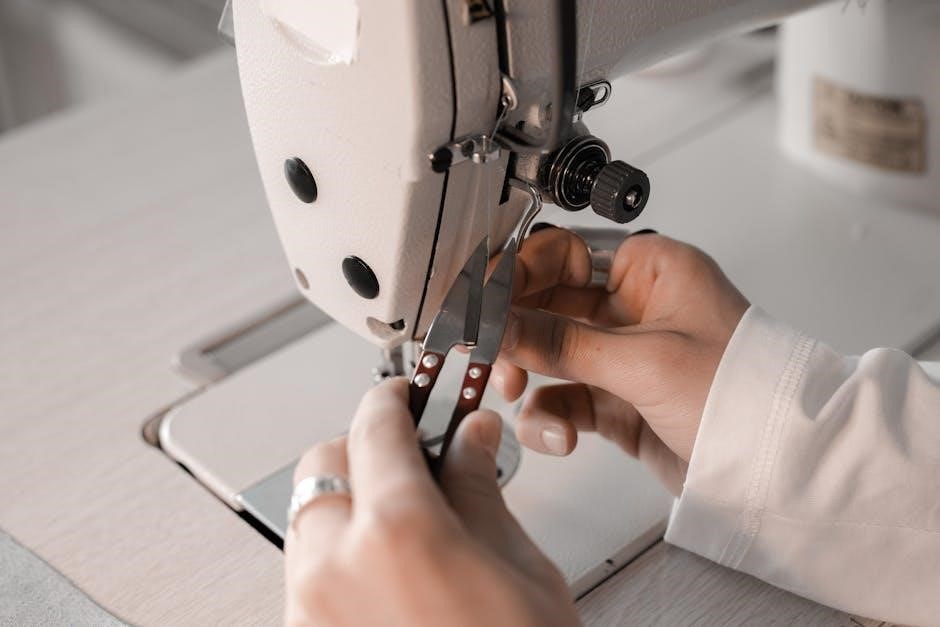
Threading
Proper threading is essential for smooth stitching․ Guide the thread through the machine’s tension discs and take-up lever, ensuring it’s seated correctly․ Avoid twists or tangles․
5․1․ Threading the Machine
Properly threading your New Home sewing machine ensures smooth operation․ Begin by locating the spool pin and pulling the thread through the machine’s tension discs․ Guide the thread through the take-up lever, ensuring it is seated properly․ Avoid twists or tangles, as they can cause uneven stitching․ Gently pull the thread to test its tension․ If the thread does not move freely, check for kinks or incorrect routing․ Always refer to your manual for specific diagrams or illustrations to ensure accurate threading․ Proper threading prevents issues like thread breakage or inconsistent stitches․
5․2․ Threading the Bobbin
Threading the bobbin correctly is essential for balanced stitching on your New Home sewing machine․ Begin by winding the bobbin with the appropriate thread, ensuring it is evenly filled but not overfilled․ Guide the thread through the bobbin winder’s designated slot and secure it․ Once wound, insert the bobbin into the bobbin case, making sure it seats properly․ Pull the thread gently to ensure it is not tangled or twisted․ Always refer to your manual for specific guidance, as improper threading can lead to uneven stitching or machine malfunction․
Using Different Stitches
Your New Home sewing machine offers various stitch options, including straight, zigzag, and decorative stitches․ Each stitch type serves specific purposes, enhancing your sewing projects’ versatility and quality․
6․1․ Basic Stitch Types
The New Home sewing machine features essential stitches for everyday sewing․ The straight stitch is ideal for basic seaming and repairs, while the zigzag stitch is perfect for stretchy fabrics and finishing raw edges․ The backstitch option reinforces seams, ensuring durability․ These foundational stitches are versatile and suitable for a wide range of projects, from garments to home decor․ Understanding and mastering these basics will enhance your sewing experience and provide a solid foundation for more complex techniques․
6․2․ Advanced Techniques
Advanced techniques on the New Home sewing machine unlock creative possibilities․ Decorative stitching adds embellishments, while heirloom stitching creates delicate, vintage-inspired designs․ Quilting stitches are ideal for layering fabrics, and the machine’s precision ensures even stitching․ Specialized stitches, like the stretch stitch, are perfect for knit fabrics․ By experimenting with these advanced features, users can elevate their projects, from intricate garments to complex home decor․ These techniques expand the machine’s versatility, catering to both skilled sewists and those looking to challenge their skills․
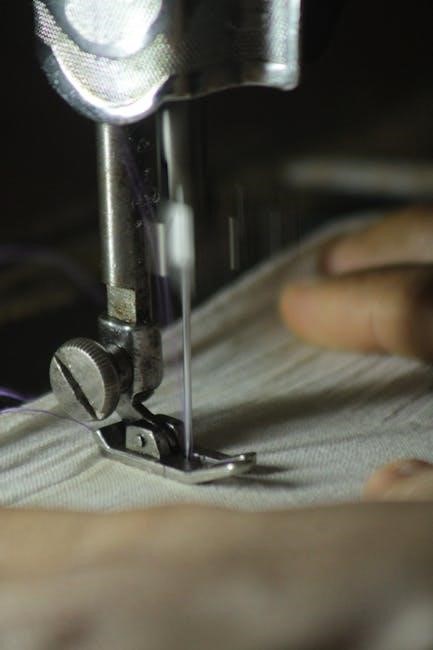
Troubleshooting
Troubleshooting helps resolve common issues like uneven stitching or machine jams․ Check thread tension, ensure proper needle alignment, and clean lint buildup regularly for smooth operation․
7․1․ Common Issues
Common issues with New Home sewing machines often include thread breaking, needle breakage, and improper tension settings․ These problems can lead to poor stitch quality or even machine jams․ Additionally, incorrect needle alignment and lint buildup in the bobbin area are frequent culprits behind uneven stitching or skipped stitches․ Addressing these issues promptly ensures smooth operation and extends the machine’s lifespan․ Regular maintenance, like cleaning and oiling, can prevent many of these problems․
7․2; Solutions
To resolve common issues, start by checking thread tension and ensuring the needle is correctly aligned․ Regularly clean lint from the bobbin area to prevent jams․ Use the appropriate needle type and size for your fabric to avoid breakage․ Adjust the presser foot pressure if fabric is not feeding smoothly․ Lubricate moving parts periodically to maintain smooth operation․ For persistent problems, consult the manual or contact a professional technician․ Addressing issues early prevents further damage and ensures optimal performance․
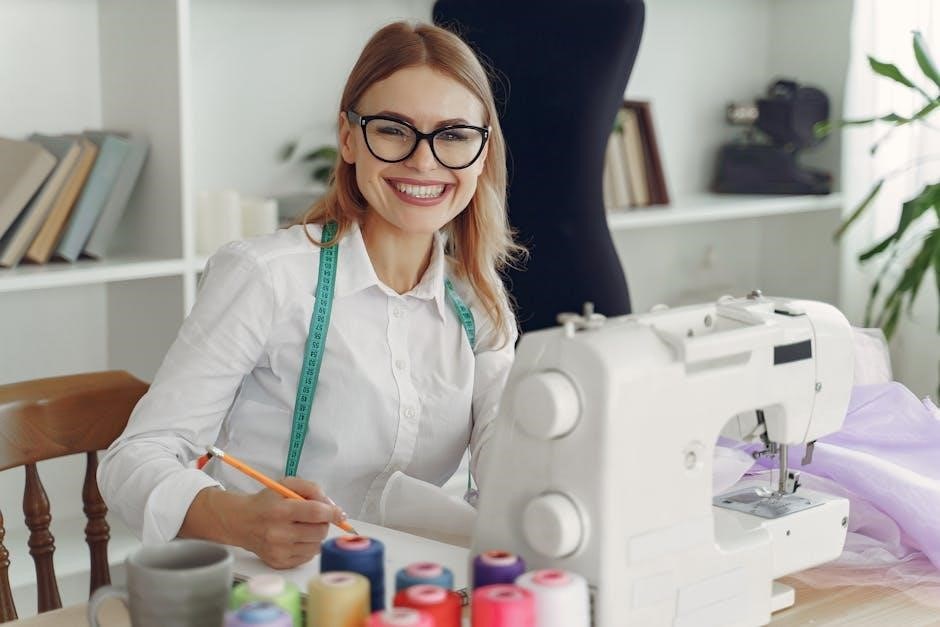
Accessories
Accessories like presser feet, embroidery hoops, and extension tables enhance sewing capabilities․ Additional attachments, such as zipper and buttonhole feet, expand creative options for various projects․
8․1․ Presser Feet
Presser feet are essential for guiding fabric and preventing slippage during sewing․ The All-Purpose Foot is ideal for straight stitching, while the Zipper Foot ensures precise edge alignment․ The Blind Hem Foot is designed for creating invisible hems, and the Buttonhole Foot simplifies creating consistent buttonholes․ Other specialized feet, like the Walking Foot or Teflon Foot, handle heavy or delicate fabrics․ Always consult your manual to identify the correct foot for your project and learn how to attach it properly․ Using the right presser foot enhances stitching quality and makes sewing easier․
8․2․ Other Attachments
Beyond presser feet, New Home sewing machines offer various attachments to enhance functionality․ The Ruffler Attachment gathers fabric evenly, ideal for ruffles or drapes․ The Quilter Attachment is designed for precise quilt piecing and stitching․ An Edge Joiner Attachment aligns fabric edges perfectly for seamless joining․ Additional attachments like Hemmers and Binders simplify hemming and binding processes․ These accessories expand the machine’s versatility, allowing for specialized tasks with ease․ Always refer to your manual to explore compatibility and usage instructions for these attachments․
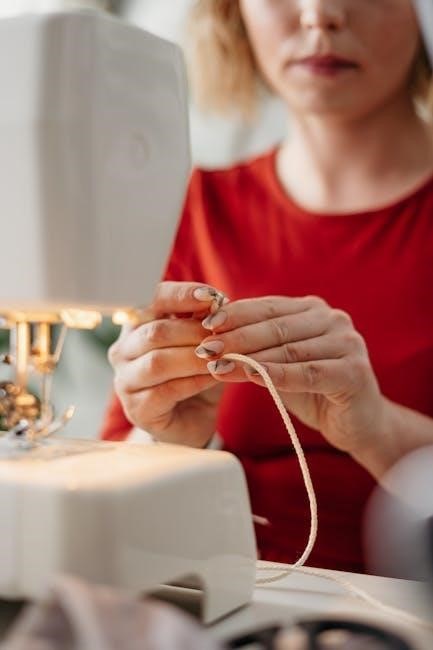
History of New Home Sewing Machines
New Home Sewing Machines have a rich history dating back to the 1860s, founded by William Newton in the United States․ Known for innovation, the company introduced the lockstitch mechanism, revolutionizing home sewing․ During the Civil War, New Home produced uniforms, establishing its reputation for durability․ The brand became a household name, offering affordable, reliable machines․ Over the years, New Home sewing machines evolved with technological advancements while maintaining their legacy of quality and versatility, making them a trusted choice for generations of sewists․
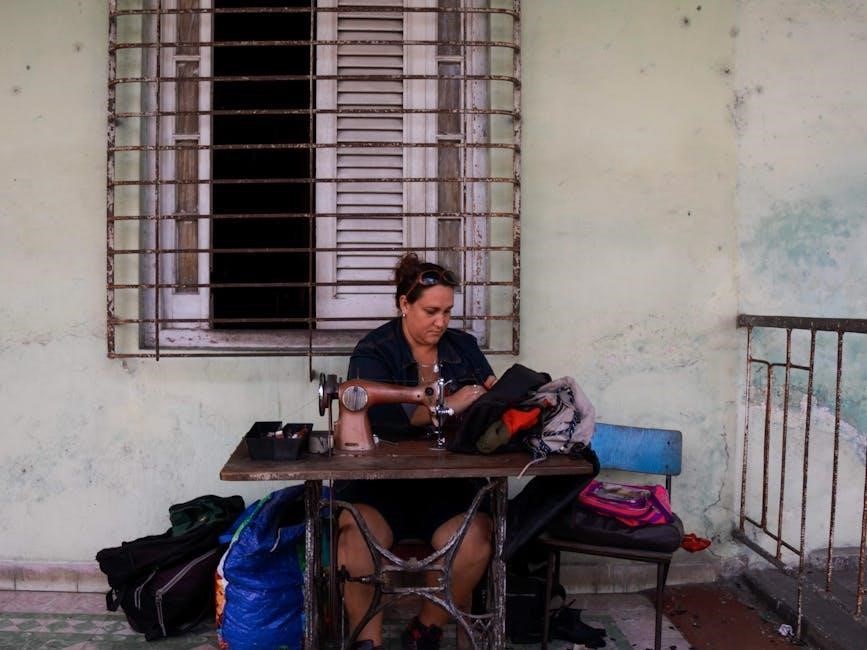
Setting Up Your Sewing Space
Creating an efficient sewing space is essential for a enjoyable experience․ Choose a well-lit area with natural light if possible․ Use a sturdy table or desk to support your machine․ Keep essential tools like scissors, threads, and needles within reach․ Install task lighting to reduce eye strain․ Store fabrics and accessories in labeled bins or shelves․ Ensure good ventilation and maintain a clean workspace․ Consider ergonomics by positioning your machine at a comfortable height to avoid strain․ A well-organized sewing area enhances productivity and creativity, making your sewing sessions more enjoyable․
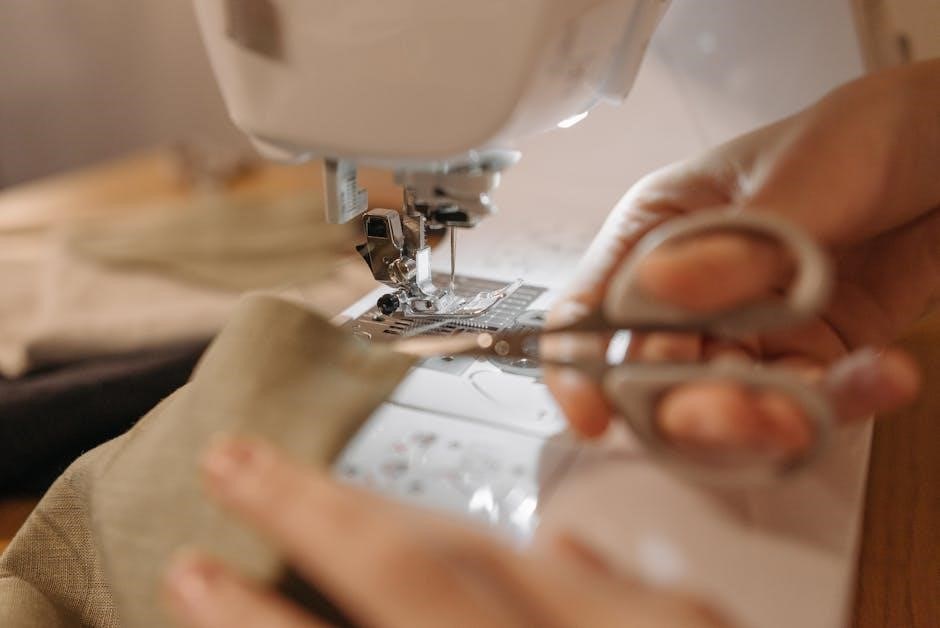
Learning to Sew
Learning to sew with a New Home machine begins with mastering basic stitches․ Start by practicing straight lines and simple seams on scrap fabric․ Familiarize yourself with the machine’s stitch selection and tension settings․ Begin with straightforward projects like pillowcases or tote bags to build confidence․ Understand how to thread the machine and manage the bobbin․ Don’t be discouraged by initial mistakes—patience is key․ Gradually experiment with more complex patterns and techniques․ Refer to your manual or online tutorials for step-by-step guidance․ Sewing is a skill that improves with practice, so enjoy the creative journey!
Community and Support
The sewing community offers invaluable support for New Home sewing machine users․ Join online forums, Facebook groups, and Reddit communities dedicated to sewing and vintage machines․ These platforms allow you to share tips, ask questions, and learn from experienced sewists․ Local sewing meetups and classes provide hands-on guidance and networking opportunities․ Additionally, online tutorials and YouTube channels often feature demonstrations specific to older machines․ Engaging with these resources fosters creativity, troubleshooting, and a sense of belonging among sewists․ They are essential for maximizing your sewing experience and preserving the legacy of your New Home machine․
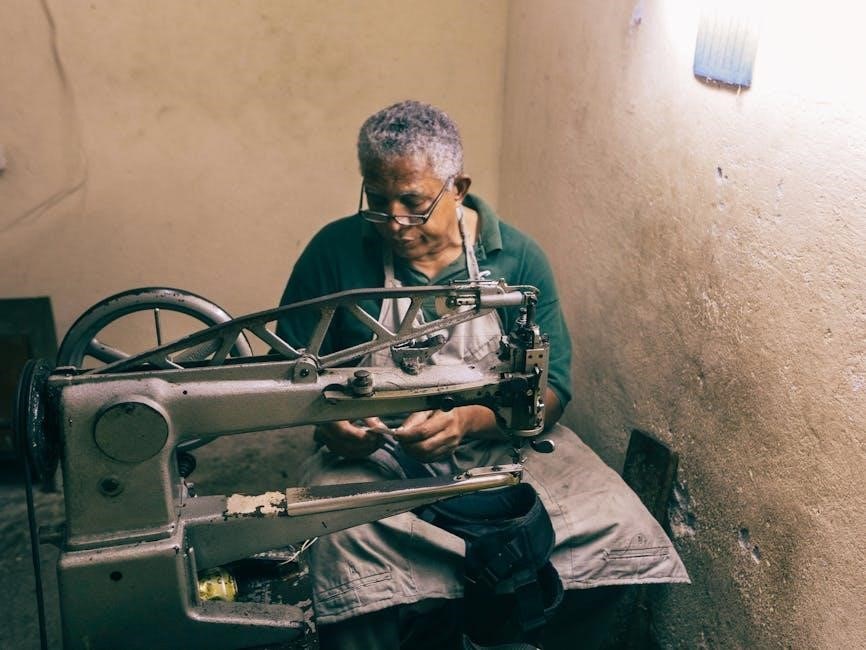
Repair and Service
Regular servicing is crucial to maintain your New Home sewing machine’s performance․ For minor repairs, such as replacing belts or cleaning internal mechanisms, consult your manual for guidance․ For complex issues like timing adjustments or electrical problems, seek a professional technician specializing in vintage machines․ Authorized service centers or skilled repair shops can ensure proper restoration․ Always use genuine or compatible parts to preserve your machine’s functionality․ Routine maintenance and timely repairs will extend the lifespan of your New Home sewing machine and keep it operational for years to come․
Environmental Impact
Manual New Home sewing machines are eco-friendly, as they operate without electricity, reducing energy consumption․ Their mechanical design minimizes electronic waste compared to modern automated machines․ By maintaining and repairing these machines, users extend their lifespan, reducing the need for frequent replacements․ Additionally, sewing with manual machines encourages the use of sustainable fabrics and eco-conscious practices․ This approach aligns with a greener lifestyle, promoting longevity and reducing environmental footprint․ Embracing manual sewing supports sustainable textile practices and responsible resource use․
Manual New Home sewing machines are timeless tools that combine durability, simplicity, and versatility․ By following this guide, users can unlock their full potential, from identifying models to mastering advanced techniques․ Proper maintenance and care ensure longevity, while the machine’s eco-friendly design supports sustainable sewing practices․ Whether for beginners or experienced sewists, these machines offer a rewarding creative experience․ Embrace the heritage of New Home sewing machines and enjoy the satisfaction of crafting with precision and care․